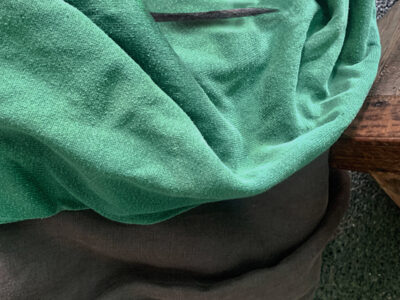Patterns aren’t just for understanding behavior. Your skin problem’s pattern can be the very roadmap to its solution!
Look at your skin. Really look at it. If you observe your acne, rashes, dry patches, and dark splotches as carefully as you would an inkblot test, you might be surprised at how much your skin is telling you about the causes of its problems…and how to fix them.
Face
You indulged in a new moisturizer and all you got was an angry, red rash? Curse you, moisturizer! Before you take a pitchfork to that tube, study the pattern of the redness carefully. For the moisturizer to be a good suspect, the redness should appear over most of the entire face, which is how you normally apply a moisturizer. If you notice that the reaction is concentrated in specific areas, you’re better off looking at another product that you tend to use on those areas, even if you’ve never had a problem with that product before (irritations and allergies can develop over time).
If you notice that the skin reaction is worse on one side of the face, think about where you normally sit in the car, on the bus, at home, and in the office. Does that side tend to face a window or be closer to a lamp? You might be looking at a photosensitive reaction — redness or darkening due to exposure to sun or light, or from allergens in your skincare or makeup reacting to sun or light.
Your bedsheets could also be a problem: if you tend to sleep on one side more than another, allergy- or acne-causing materials in your pillowcase or ingredients in your laundry detergent could be causing your skin reaction.
Forehead, Cheeks, Upper Back
Is your acne concentrated on the forehead, cheeks, or upper back? It might be caused by your shampoo, conditioner, and hair styling products. Comedogens (ingredients that clog pores) and allergens (which can irritate pores and lead to infection, then acne) in some of these products could trickle down onto the skin (particularly with sweat) to cause acne and other skin problems.
If you use helmets for biking or sports, or headscarves or hats, consider them, too. Many contain rubber, dyes, bleaches, and preservatives, which can all cause skin problems.
Around the Eyes
Do you wear glasses with metal parts? Nickel is regularly at the top of published lists of common allergens, and reactions on the nose, ears, and around the eyes could point to a nickel sensitivity. Eyewear without metal parts may not be entirely safe for you either if they contain allergens like benzophenones in the plastic or thiuram in rubberized parts.
A case study was presented where a woman was erroneously diagnosed with vitiligo (loss of pigment in the skin) due to whitened patches around her eyes. A dermatologist suspicious of the symmetry of the whitening ordered a patch test. The results showed that the patient was sensitive to rubber. As the patient worked in a laboratory, the doctor asked if she used protective eyewear. It turns out that the patient had developed hypo-pigmentation (loss of pigmentation) as a reaction to the rubber on her lab goggles.
Eye makeup and eye serums can also be an issue, of course, and a reaction to this would normally be concentrated on the areas of application.
Mouth, Lips, Chin, Jaw
If you have chronic dryness and blisters on the lips, check out this case study showing how simple avoidance — in this case, of mint and nickel (the patient’s allergens) — can be powerful at clearing up a problem entirely! If you share this patient’s allergies, avoiding mint may seem simple but allergens often cross-react or are related to other allergens…so we’d suggest avoiding flavors altogether.
Nickel can be present in braces. If you’ve tested positive for a nickel allergy, make sure to tell your dentist and orthodontist about it.
Some colors used in lipsticks can contain nickel. Ask the manufacturer about the concentration of nickel in their dyes or pigments to be sure (note that a nickel sensitivity often comes with a cobalt sensitivity, too).
Nickel can also be present in mordants, or metals in fabrics. If you tend to use scarves, opt for natural, uncolored fabrics because mordants are used to help dyes adhere to cloth.
There are other allergens present in fabrics. If your problems seem to be where your skin tends to come into contact with clothing, ask your doctor about a patch test with clothing allergens included. Safer scarf options include pale, natural colors and non-scratchy, non-stretchy fabrics.
We also regularly see acne, dryness, darkening, rashes and other problems around the mouth and on the chin, lips, and/or jawline as a result to a sensitivity to fluoride and flavors in toothpastes and oral care products (peri-oral dermatitis) which also responds dramatically to simple avoidance. A halogen sensitivity also benefits from avoiding iodides, bromides, chlorine, and similar substances (check out this halogen-Free Diet for a great guide).
Hands & Feet
Notice some random, and stubborn, dryness on your fingers? If it’s on the the thumb and the index finger, it could be from holding coffee mugs with metals or rubbers on the handles. Or, as in the case of one psoriasis patient, from touching paper! This patient’s psoriasis was finally well controlled. Part of her successful management was her disciplined avoidance of her allergens: dyes and preservatives. Still, she had dry, scaly patches on one hand that just wouldn’t go away.
Her dermatologist grilled her about what she was using that could be causing the patches. The patient was adamant: nothing! Because she was so happy about her therapy’s success, she was exacting about avoiding dyes and preservatives, and was (rightfully, in our opinion…it’s not easy) proud of it. The doctor persisted, asking if the patient had begun working again (she was retired) or had any other changes in her life that could be sources of accidental exposure. They finally got to new hobbies. The patient said that she had recently started playing weekly bingo. Delving deeper, the dermatologist asked the patient to show him what she used when playing the game. The patient returned with an ink-stained marker and paper. Sure enough, where her skin came into contact with the ink and where she rested her hand on the paper (thiourea, one of her allergens, is related to dyes and preservatives and is common in paper) matched the pattern of her dry, scaly patches. After just a few weeks of minimizing contact with the pen and paper, the patient was scale-free from head to toe.
Problems on the feet can be due to elastics in socks, as well as rubbers, colorants, metals, or glues in shoes. Laundry detergent could also be a factor.
An interesting case we are monitoring is of a patient whose irritations are on the soles of the feet, and who is mostly allergic to propolis. His doctor is narrowing in on the possibility of the wooden floors of the patient’s home possibly containing propolis from floor wax…or even as a transfer from bees!
For either hands or feet, if the nails or webbing between the toes are involved, make sure to consult a dermatologist to rule out other skin conditions.
IMPORTANT: If you notice a dark spot that looks almost like a bruise on the fingers or toes, don’t dismiss it so easily. Show it to your dermatologist at your next skin cancer screening as it could be an early sign of some skin cancers (even in non-white skin).
Underarm & Body
A doctor shared a fascinating case of a patient whose underarm darkening would not go away. The patient had already switched over to our allergen-free Essence Skin-Saving Antiperspirant, Essence Skin-Saving Body Washes and Fawn & Launder Hypoallergenic Laundry, and was conscientious about not using any other products on the area.
The doctor reviewed her case in detail. The patient’s patch test showed an allergic reaction to metals and nothing else. She asked the patient to come in again so that she could take another look at the darkened area. The doctor noticed that the darkened skin was in a pattern: the darkening was limited to a circle at the perimeter of the underarm, and there was no darkening in the center. This perimeter area is where the skin would most come into contact with shirt sleeve openings and the sides of a bra. Thinking back to the patch test results, the doctor asked the patient to use only white or otherwise un-dyed materials in bras and shirts. It took a few months but the darkening subsided significantly.
Why did this darkening happen if the patient was primarily allergic to metals? In addition to causing redness, dryness, scaling, itching and other abnormal symptoms, an allergy to metal can also cause darkening…and there are often hidden metals in clothing. As mentioned above, mordants are chemicals that are added to clothing to help dyes adhere to fabric. This is why, when the patient stopped using fabrics with color, the darkening subsided.
Due to their function, mordants are common in colored clothing, including denim. The photo below shows a man’s metal allergy on the upper thigh due to the mordants in his jeans (for other people, a common problem the blue colorant, indigo). This patient was highly allergic to nickel, and his pattern revealed that he was also reacting to the nickel in his cell phone, which he tended to keep in his pocket:

If the itching, redness or darkening is on your knees or around the groin area where clothing tends to gather or crease, you could be reacting to your clothing or underwear. Use allergen-free body cleansers, wash your clothing in hypoallergenic laundry soap, and choose clothing that is less stretchy and as un-colored as possible.
Patterns Matter
If you have stubborn darkening, redness, dryness, itching, acne or other skin problems, pay close attention to where they occur. Patterns can be helpful in determining the causes of skin problems, as can a patch test and an investigative dermatologist.
In addition to our allergen-free products, if you have clothing contact dermatitis we suggest browsing through dye, latex and rubber-free clothing like those offered by Cottonique. Fun fact: one of Cottonique’s founders was a patient of our founding dermatologist-dermatopathologist — he started the company after her diagnosis of his clothing contact dermatitis.
Disclosure: VMV has no commercial or other relationship with Cottonique except having done a clinical study for how their allergen-free clothing can help those with clothing contact dermatitis.
“Dew” More:
To shop our selection of validated hypoallergenic products, visit vmvhypoallergenics.com. Need help? Leave a comment below, contact us by email, or drop us a private message on Facebook.
If you have a history of sensitive skin, don’t guess: random trial and error can cause more damage. Ask your dermatologist about a patch test.
Learn more:
On the prevalence of skin allergies, see Skin Allergies Are More Common Than Ever and One In Four Is Allergic to Common Skin Care And Cosmetic Ingredients.
To learn more about the VH-Rating System and hypoallergenicity, click here.


